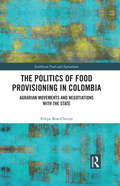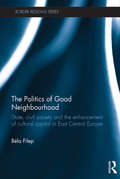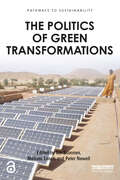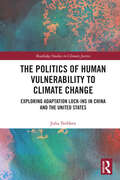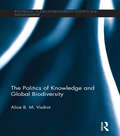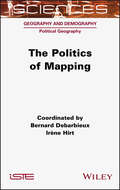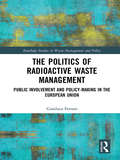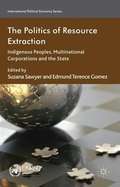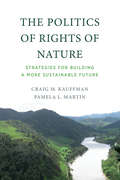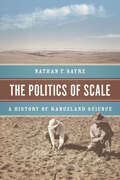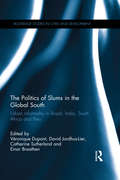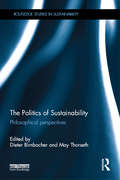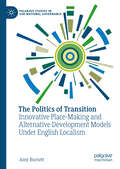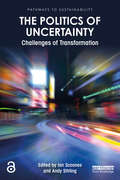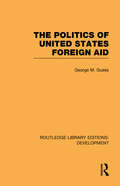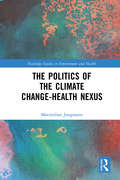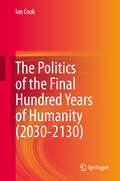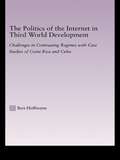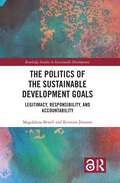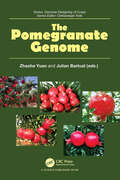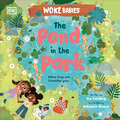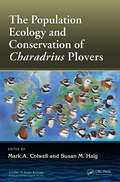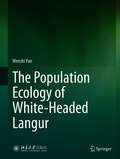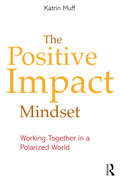- Table View
- List View
The Politics of Food Provisioning in Colombia: Agrarian Movements and Negotiations with the State (Earthscan Food and Agriculture)
by Felipe Roa-ClavijoThis book explores food provisioning in Colombia by examining the role and impact of the agrarian negotiations which took place in the aftermath of the 2013–2014 national strikes. Most of the research in the field of agrarian studies in Colombia has focused on inequalities in land distribution, the impacts of violent conflict, and most recently, the first phase of the peace agreement implementation. This book links and complements these literatures by critically engaging with an original framework that uncovers the conflicts and politics of food provisioning: who produces what and where, and with what socio-economic effects. This analytical lens is used to explain the re-emergence of national agrarian movements, their contestation of the dominant development narratives and their engagement in discussions about food sovereignty with the state. The analysis incorporates a wide range of voices from high-level government representatives and leaders from national agrarian movements. Their narratives of food provisioning and the broader role of the food industry are reviewed and the key findings show an underlying conflict within food provisioning based on the struggle of marginalised smallholders to develop alternative agri-food systems that can be included in the local and domestic food markets in the context of a state dominated by an export and import approach. Overall, the book argues that the battle ground of agrarian conflicts has moved to the fi eld of food provisioning and using this approach has the potential to reframe the debate about the future of food and agriculture in Colombia and beyond. This book will be of great interest to students and scholars of food and agriculture, rural development, peasant studies, and Latin American Studies.
The Politics of Good Neighbourhood: State, civil society and the enhancement of cultural capital in East Central Europe (Border Regions Series)
by Béla FilepAnalyzing neighbourly relations in multicultural societies, this book develops a concept of good neighbourhood and argues that cultural capital in various forms is the determining variable in building good-neighbourly relations. This work breaks new ground by offering a conceptual integration of different, mutually interdependent forms of capital: intercultural capital, cross- cultural social capital and multicultural capital. These forms of capital are linked to different educational and cultural policies of the state as well as to civil society involvement at different levels of implementation. Grounded in extensive fieldwork, the book not only provides critical insights into neighbourly relations in culturally diverse border regions of East Central Europe, but the concept developed through a rich theoretical base can be usefully adapted and widely applied to other contexts. Scholars and graduate- level students in geography, international relations, political science, social anthropology and sociology as well as policy practitioners with an interest in the negotiation of coexistence, minority issues and social and political cohesion in multicultural societies will find this an illuminating read.
The Politics of Green Transformations (Pathways to Sustainability)
by Peter Newell Ian Scoones Melissa LeachMultiple ‘green transformations’ are required if humanity is to live sustainably on planet Earth. Recalling past transformations, this book examines what makes the current challenge different, and especially urgent. It examines how green transformations must take place in the context of the particular moments of capitalist development, and in relation to particular alliances. The role of the state is emphasised, both in terms of the type of incentives required to make green transformations politically feasible and the way states must take a developmental role in financing innovation and technology for green transformations. The book also highlights the role of citizens, as innovators, entrepreneurs, green consumers and members of social movements. Green transformations must be both ‘top-down’, involving elite alliances between states and business, but also ‘bottom up’, pushed by grassroots innovators and entrepreneurs, and part of wider mobilisations among civil society. The chapters in the book draw on international examples to emphasise how contexts matter in shaping pathways to sustainability Written by experts in the field, this book will be of great interest to researchers and students in environmental studies, international relations, political science, development studies, geography and anthropology, as well as policymakers and practitioners concerned with sustainability.
The Politics of Human Vulnerability to Climate Change: Exploring Adaptation Lock-ins in China and the United States (Routledge Studies in Climate Justice)
by Julia TeebkenThis book compares how the social consequences of climate change are similarly unevenly distributed within China and the United States, despite different political systems. Focusing on the cases of Atlanta, USA, and Jinhua, China, Julia Teebken explores a set of path-dependent factors (lock-ins), which hamper the pursuit of climate adaptation by local governments to adequately address the root causes of vulnerability. Lock-ins help to explain why adaptation efforts in both locations are incremental and commonly focus on greening the environment. In both these political systems, vulnerability appears as a core component along with the reconstitution of a class-based society. This manifests in the way knowledge and political institutions operate. For this reason, Teebken challenges the argument that China’s environmental authoritarian structures are better equipped in dealing with matters related to climate change. She also interrogates the proposition that certain aspects of the liberal democratic tradition of the United States are better suited in dealing with social justice issues in the context of adaptation. Overall, the book’s findings contradict the widespread assumption that developed countries necessarily have higher adaptive capacity than developing or emerging economies. This volume will be of great interest to students and scholars of climate justice and vulnerability, climate adaptation and environmental policy and governance.
The Politics of Knowledge and Global Biodiversity (Routledge Studies in Biodiversity Politics and Management)
by Alice B.M. VadrotThe establishment of the Intergovernmental Platform on Biodiversity and Ecosystem Services (IPBES) points to the crucial role attributed to science and knowledge for the successful implementation of biodiversity politics by both scientists and policy-makers. With the increased importance of biodiversity in international politics, and in part inspired by the success the Intergovernmental Panel on Climate Change (IPCC) has had in raising awareness of global warming, the call for an ‘IPCC for Biodiversity’ was successful. The Politics of Knowledge and Global Biodiversity gives a full overview of the process of its implementation as finalised in 2013 and proposes an innovative conceptual framework that puts this specific case into a more general perspective of international politics and relations. It provides a detailed empirical analysis of the knowledge politics associated with the establishment of IPBES and its conceptual framework and methodological approach is grounded in a theoretical perspective. This pioneering work is the first to examine IPBES in this way and is essential reading for researchers and scholars of International Relations, Environmental and Biodiversity Politics, Science-Policy Interfaces and Global Environmental Governance. It will also be of interest to political scientists and social scientists.
The Politics of Mapping
by Bernard Debarbieux Irene HirtMaps and mapping are fundamentally political. Whether they are authoritarian, hegemonic, participatory or critical, they are most often guided by the desire to have control over space, and always involve power relations. This book takes stock of the knowledge acquired and the debates conducted in the field of critical cartography over some thirty years.The Politics of Mapping includes analyses of recent semiological, social and technological innovations in the production and use of maps and, more generally, geographical information. The chapters are the work of specialists in the field, in the form of a thematic analysis, a theoretical essay, or a reflection on a professional, scientific or militant practice. From mapping issues for modern states to the digital and big data era, from maps produced by Indigenous peoples or migrant–advocacy organizations in Europe, the perspectives are both historical and contemporary.
The Politics of Radioactive Waste Management: Public Involvement and Policy-Making in the European Union (Routledge Studies in Waste Management and Policy)
by Gianluca FerraroEnvironmental concerns have pushed the decarbonisation of the European economy high on the EU political agenda. This has renewed old debates about the role of nuclear energy in the European economy and society that gravitate around the issues of nuclear safety and radioactive waste management (RWM). RWM carries many elements of technical complexity, scientific uncertainty and social value, which makes policy decisions highly controversial. Public participation is usually believed to improve these decisions, ease their implementation by solving substantial conflicts, and enhance trust and social acceptance. Drawing upon sources including Euratom and the OECD Nuclear Energy Agency, the author offers a detailed overview of public involvement in RWM in the EU, analysing the implementation of national policies through official programmes and the views of stakeholders from all Member States. This book highlights the key successes and challenges in the quest for greater participation in RWM, and extrapolates insights for other contested energy infrastructures and controversies in land use. This book will be of great relevance to students, scholars and practitioners with an interest in radioactive waste management, energy policy, and EU environmental politics and policy.
The Politics of Resource Extraction
by Suzana Sawyer Edmund Terence GomezInternational institutions (United Nations, World Bank) and multinational companies have voiced concern over the adverse impact of resource extraction activities on the livelihood of indigenous communities. This volume examines mega resource extraction projects in Australia, Bolivia, Canada, Chad, Cameroon, India, Nigeria, Peru, the Philippines.
The Politics of Rights of Nature: Strategies for Building a More Sustainable Future
by Pamela L. Martin Craig M. KauffmanHow Rights of Nature laws are transforming governance to address environmental crises through more ecologically sustainable approaches to development. With the window of opportunity to take meaningful action on climate change and mass extinction closing, a growing number of communities, organizations, and governments around the world are calling for Rights of Nature (RoN) to be legally recognized. RoN advocates are creating new laws that recognize natural ecosystems as subjects with inherent rights, and appealing to courts to protect those rights. Going beyond theory and philosophy, in this book Craig Kauffman and Pamela Martin analyze the politics behind the creation and implementation of these laws, as well as the effects of the laws on the politics of sustainable development. Kauffman and Martin tell how community activists, lawyers, judges, scientists, government leaders, and ordinary citizens have formed a global movement to advance RoN as a solution to the environmental crises facing the planet. They compare successful and failed attempts to implement RoN at various levels of government in six countries--Bolivia, Colombia, Ecuador, India, New Zealand, and the United States--asking why these laws emerged and proliferated in the mid-2000s, why they construct RoN differently, and why some efforts at implementation are more successful than others. As they analyze efforts to use RoN as a tool for constructing more ecocentric sustainable development, capable of achieving the 2030 Agenda for Sustainable Development goal of living "in harmony with Nature," Kauffman and Martin show how RoN jurisprudence evolves through experimentation and reshapes the debates surrounding sustainable development.
The Politics of Scale: A History of Rangeland Science
by Nathan F. SayreRangelands are vast, making up one quarter of the United States and forty percent of the Earth’s ice-free land. And while contemporary science has revealed a great deal about the environmental impacts associated with intensive livestock production—from greenhouse gas emissions to land and water degradation—far less is known about the historic role science has played in rangeland management and politics. Steeped in US soil, this first history of rangeland science looks to the origins of rangeland ecology in the late nineteenth-century American West, exploring the larger political and economic forces that—together with scientific study—produced legacies focused on immediate economic success rather than long-term ecological well being. During the late 1880s and early 1890s, a variety of forces—from the Homestead Act of 1862 to the extermination of bison, foreign investment, and lack of government regulation—promoted free-for-all access to and development of the western range, with disastrous environmental consequences. To address the crisis, government agencies turned to scientists, but as Nathan F. Sayre shows, range science grew in a politically fraught landscape. Neither the scientists nor the public agencies could escape the influences of bureaucrats and ranchers who demanded results, and the ideas that became scientific orthodoxy—from fire suppression and predator control to fencing and carrying capacities—contained flaws and blind spots that plague public debates about rangelands to this day. Looking at the global history of rangeland science through the Cold War and beyond, The Politics of Scale identifies the sources of past conflicts and mistakes and helps us to see a more promising path forward, one in which rangeland science is guided less by capital and the state and more by communities working in collaboration with scientists.
The Politics of Slums in the Global South: Urban Informality in Brazil, India, South Africa and Peru (Routledge Studies in Cities and Development)
by Véronique Dupont David Jordhus-Lier Catherine Sutherland Einar BraathenSeeing urban politics from the perspective of those who reside in slums offers an important dimension to the study of urbanism in the global South. Many people living in sub-standard conditions do not have their rights as urban citizens recognised and realise that they cannot rely on formal democratic channels or governance structures. Through in-depth case studies and comparative research, The Politics of Slums in the Global South: Urban Informality in Brazil, India, South Africa and Peru integrates conceptual discussions on urban political dynamics with empirical material from research undertaken in Rio de Janeiro, Delhi, Chennai, Cape Town, Durban and Lima. The chapters engage with the relevant literature and present empirical material on urban governance and cities in the South, housing policy for the urban poor, the politics of knowledge and social mobilisation. Recent theories on urban informality and subaltern urbanism are explored, and the issue of popular participation in public interventions is critically assessed. The book is aimed at a scholarly readership of postgraduate students and researchers in development studies, urban geography, political science, urban sociology and political geography. It is also of great value to urban decision-makers and practitioners.
The Politics of Sustainability: Philosophical perspectives (Routledge Studies in Sustainability)
by Dieter Birnbacher May ThorsethResponsibility for future generations is easily postulated in the abstract but it is much more difficult to set it to work in the concrete. It requires some changes in individual and institutional attitudes that are in opposition to what has been called the "systems variables" of industrial society: individual freedom, consumerism, and equality. The Politics of Sustainability from Philosophical Perspectives seeks to examine the motivational and institutional obstacles standing in the way of a consistent politics of sustainability and to look for strategies to overcome them. It argues that though there have been significant changes in individual and especially collective attitudes to growth, intergenerational solidarity and nature preservation, it is far from certain whether these will be sufficient to encourage politicians into giving sustainable policies priority over other legitimate concerns. Having a philosophical approach as its main focus, the volume is at the same time interdisciplinary in combining political, psychological, ecological and economic analyses. This book will be a contribution to the joint effort to meet the theoretical and practical challenges posed by climate change and other impending global perils and will be of interest to students of environmental studies, applied ethics and environmental psychology.
The Politics of Transition: Innovative Place-Making and Alternative Development Models Under English Localism (Palgrave Studies in Sub-National Governance)
by Amy BurnettThis book explores the impact of recent planning reforms on emergent, alternative models of local governance. It uses the pioneering approach of Frome in Somerset, UK to showcase development and governance alternatives in a post-Brexit landscape. It investigates the role of planning in contributing to sustainable development under localism, and examines how key actors have used the Neighbourhood Planning process to put forward niche, community-based development futures. In doing so, the book offers valuable methodological, empirical and theoretical contributions to wider debates concerning transition, placemaking, local politics and planning. It will appeal to all those interested in public policy and governance.
The Politics of Uncertainty: Challenges of Transformation (Pathways to Sustainability)
by Ian ScoonesWhy is uncertainty so important to politics today? To explore the underlying reasons, issues and challenges, this book’s chapters address finance and banking, insurance, technology regulation and critical infrastructures, as well as climate change, infectious disease responses, natural disasters, migration, crime and security and spirituality and religion. The book argues that uncertainties must be understood as complex constructions of knowledge, materiality, experience, embodiment and practice. Examining in particular how uncertainties are experienced in contexts of marginalisation and precarity, this book shows how sustainability and development are not just technical issues, but depend deeply on political values and choices. What burgeoning uncertainties require lies less in escalating efforts at control, but more in a new – more collective, mutualistic and convivial – politics of responsibility and care. If hopes of much-needed progressive transformation are to be realised, then currently blinkered understandings of uncertainty need to be met with renewed democratic struggle. Written in an accessible style and illustrated by multiple case studies from across the world, this book will appeal to a wide cross-disciplinary audience in fields ranging from economics to law to science studies to sociology to anthropology and geography, as well as professionals working in risk management, disaster risk reduction, emergencies and wider public policy fields.
The Politics of United States Foreign Aid (Routledge Library Editions: Development)
by George M. GuessFirst published in 1987, this reissue explores contemporary United States foreign aid policies and thinking in the Reagan era. The author argues that aid policy is often confused as a result of bureaucratic decision-making processes. The book contrasts the experience of the many countries where aid-giving has produced unwished-for effects with the few countries where the desired results have occurred. The author concludes by arguing for a new approach to aid-giving by the United States.
The Politics of the Climate Change-Health Nexus (Routledge Studies in Environment and Health)
by Maximilian JungmannThis book compares how governments in 192 countries perceive climate change related health risks and which measures they undertake to protect their populations. Building on case studies from the United Kingdom, Ireland, South Korea, Japan and Sri Lanka, The Politics of the Climate Change-Health Nexus demonstrates the strong influence of epistemic communities and international organisations on decision making in the field of climate change and health. Jungmann shows that due to the complexity and uncertainty of climate change related health risks, governments depend on the expertise of universities, think tanks, international organisations and researchers within the public sector to understand, strategize and implement effective health adaptation measures. Due to their general openness towards new ideas and academic freedom, the book shows that more democratic states tend to demonstrate a higher recognition of the need to protect their populations. However, the level of success largely depends on the strength of their epistemic communities and the involvement of international organisations. This volume will be of great interest to students and scholars of climate change and public health. It will also be a valuable resource for policymakers from around the world to learn from best practices and thus improve the health adaptation work in their own countries.
The Politics of the Environment
by Neil CarterThe continuous rise in the profile of the environment in politics reflects growing concern that we may be facing a large-scale ecological crisis. The new edition of this highly acclaimed textbook surveys the politics of the environment, providing a comprehensive and comparative introduction to its three components: ideas, activism and policy. Part I explores environmental philosophy and green political thought; Part II considers parties and environmental movements; and Part III analyses policy-making and environmental issues at international, national and local levels. This second edition has been thoroughly updated with new and revised discussions of many topics including the ecological state, ecological citizenship, ecological modernisation and the Greens in government and also includes an additional chapter on 'Globalisation, trade and the environment'. As well as considering a wide variety of examples from around the world, this textbook features a glossary, guides to further study, chapter summaries and critical questions throughout. Book jacket.
The Politics of the Final Hundred Years of Humanity (2030-2130)
by Ian CookThis book is the first book that looks at both the politics of maintaining the trajectory toward humanity’s final hundred years and the politics of those final hundred years. It is the first book to take up theoretical and practical aspects with respect to both the movement toward and events during these final hundred years. As a result, it is the first book that attempts to provide a more complete picture of the politics of catastrophic human-caused environment change.The fact that the book provides a way into the variety of policy problems that catastrophic human-caused environment change is creating means that it is also important to those in Public Policy. The book also raises a series of philosophical and ethical questions associated with human rights, which are significant to those who study Political Philosophy (and some of those who study Law), international action to mitigate the effects of climate change, the nature of science and the limitations of political institutions.
The Politics of the Internet in Third World Development: Challenges in Contrasting Regimes with Case Studies of Costa Rica and Cuba
by Bert HoffmannThis book examines the political and developmental implications of the new information and communication technologies (NICT) in the Third World. Whereas the concept of the "digital divide" tends to focus on technological and quantitative indicators, this work stresses the crucial role played by the political regime type, the pursued development model and the specific configuration of actors and decision-making dynamics. Two starkly contrasting Third World countries, state-socialist Cuba and the Latin America's "show-case democracy" Costa Rica, were chosen for two in-depth empirical country studies.
The Politics of the Sustainable Development Goals: Legitimacy, Responsibility, and Accountability (Routledge Studies in Sustainable Development)
by Magdalena Bexell Kristina JönssonThis book draws attention to political aspects of sustainable development goal-setting, exploring the Sustainable Development Goals (SDGs) at the global-national nexus during their first five years. After broad global deliberation and political negotiations, the 2030 Agenda and its SDGs were adopted in the United Nations (UN) General Assembly in 2015, and by now many countries have political structures in place for working towards their realisation. This book explores three concepts to call attention to the political qualities of processes related to the SDGs: legitimacy, responsibility, and accountability. Legitimacy is required to obtain broad political ownership for policy goals in order for them to become effective in addressing cross-border sustainability challenges. Responsibility needs to be clearly distributed among political institutions if a long-term set of broad goals such as the SDGs are to be realised. Accountability to the public is the retrospective mirror of political responsibility. The Politics of the Sustainable Development Goals contributes new knowledge on political processes at the nexus of global and national levels, focussing on three countries at different levels of socio-economic development and democratisation: namely Ghana, Tanzania, and Sweden. These countries illustrate a variety of challenges related to the realisation of the SDGs. This book will be of great interest to students and scholars of sustainable development, international organisations, and global politics.
The Pomegranate Genome (Genome Designing of Crops)
by Zhaohe Yuan Julian BartualThe volume is a comprehensive resource for researchers, scholars, and enthusiasts in the field of pomegranate research. It delves into various aspects of the pomegranate crop, providing an extensive coverage of its botany, taxonomy, germplasm conservation and utilization, genome, and functional genomics. The work provides a detailed understanding of the pomegranate's genetic makeup and its potential applications. The research presented in the book focuses on the identification and analysis of key genes and gene families of pomegranates, and sheds light on their functions and contributions to the plant's growth and development. By uncovering these genetic insights, researchers can further explore the plant's potential for agricultural improvement and its adaptation to various environmental conditions. Moreover, the book goes beyond genetic analysis and delves into the conservation and utilization of pomegranate germplasm. It provides insights into the preservation and sustainable management of the plant's genetic resources, ensuring their availability for future generations. This aspect of the book highlights the importance of maintaining biodiversity and the potential benefits it brings to agriculture and food security. It also explores a review of pomegranate genomes, multiomics, and chloroplast genome. By examining these aspects, researchers can gain a deeper understanding of the plant's molecular mechanisms, metabolic pathways, and evolutionary history. This knowledge contributes to the development of improved breeding strategies, disease resistance, and the enhancement of desirable traits in pomegranate cultivars.In conclusion, the serves as a reference for anyone interested in the botany and genetics of this unique fruit species. Its comprehensive coverage of various aspects of pomegranate research, from its genetic composition to its functional genomics and germplasm conservation, makes it a valuable tool for advancing our understanding and utilization of this remarkable crop.
The Pond in the Park: Where Frogs and Friendships Grow (Woke Babies Books)
by Flo FieldingA magical STEM story that sees frog spawn transform into frogs as Millie’s own special friendship grows.Millie has started at a new school and making friends hasn’t been easy. On a morning stroll through the park before school, Millie’s dad points out a pond filled with frog spawn and explains that soon they will go through BIG changes. Just as the frog spawn will grow and transform, can Millie embrace the changes in her life?Made in collaboration with Woke Babies, this book offers a gentle introduction to the incredible life cycle of a frog, while helping children overcome their own worries about change and new beginnings. This is a wonderful reminder that sometimes friendships take time to blossom, but it encourages children to take a chance anyway. With vivid illustrations accompanying the exciting STEM story, The Pond in the Park is the perfect gift for a little one, or for anyone looking for a heart-warming story with inspiring characters.
The Population Ecology and Conservation of Charadrius Plovers (Studies in Avian Biology #53)
by Mark A. Colwell Susan M. HaigThe 40 or so species of beach-loving plovers (genus Charadrius) comprise a diverse group of shorebirds found around the world. Most of these species are challenged by changing climates and other human-related development activities, yet they provide key insights into basic ecological and evolutionary processes. The expert international contributors take a comparative approach, presenting examples from many worldwide plover studies and synthesizing the group’s most pressing and important topics. The book further presents an emphasis on full life-cycle biology, including the importance of examining migratory connectivity issues, even for non-migratory plovers. Key Features Serves as a fundamental resource for conservation practitioners Detailed overview of a widely distributed group of shorebirds Authored by renowned specialists who present theoretical and applied perspectives Emphasis on comparative and synthetic approach in all chapters Related Titles McComb, B. et al. Monitoring Animal Populations and Their Habitats: A Practitioner’s Guide (ISBN 978-0-4291-3827-0). Garvey, J. E. & M. R. Whiles. Trophic Ecology (ISBN 978-1-4987-5846-8). Dewdney, A. K. Stochastic Communities: A Mathematical Theory of Biodiversity (ISBN 978-1-1381-9702-2).
The Population Ecology of White-Headed Langur
by Wenshi PanThis book offers a rare and detailed insight into 20 years’ of in-depth field research and conservation of the white-headed langur. It focuses on the white-headed langur’s natural refuge, territory and home range, diets and foraging strategies, behavior modes, reproductive strategies, population, possible future viabilities, and their interaction with human society. From 1996 through 2016, a small research team led by Prof.Wenshi Pan from Peking University conducted studies and conservation efforts on the white-headed langur, one of the most endangered endemic species of China, in Guangxi and saved the species from extinction. With the help of conservationists’ efforts, the white-headed langur population in Nongguan Mountains, Guangxi, gradually increased from 105 to approximately 820.This book shares the success story of the unification of human development and wildlife conservation.
The Positive Impact Mindset: Working Together in a Polarized World
by Katrin MuffWe are facing a new and urgent challenge when collaborating across organizations, and with broader stakeholder groups: how to overcome polarization. It has never been harder to find a common vision, when opinions are often considered as facts. This book empowers changemakers and business leaders to understand how successful organizations in the 21st century require leaders to become fluent in collaborating outside of traditional business boundaries. Such collaboration often involves working with parties that hold very different values, opinions and priorities, and working with them requires new skills. Building on the book Five Superpowers for Co-Creators, Katrin Muff presents a number of real-world examples that demonstrate how organizations have successfully managed to address these challenges. Examples of such unlikely but successful cross-sector collaboration include a project addressing plastic waste in Switzerland, and two European city government projects that reached out beyond organizational boundaries. The book features many stories of trial and error in overcoming the societal polarization gap. From all these insights emerges clear guidance as to how leaders and organizations can transform to new ‘outside-in’ mindsets to overcome polarization and develop a Positive Impact Mindset. The book is ideal for use by facilitators, educators, business and political leaders, and consultants, who are seeking solutions within an often polarized world to achieve sustainable change and a positive impact.
